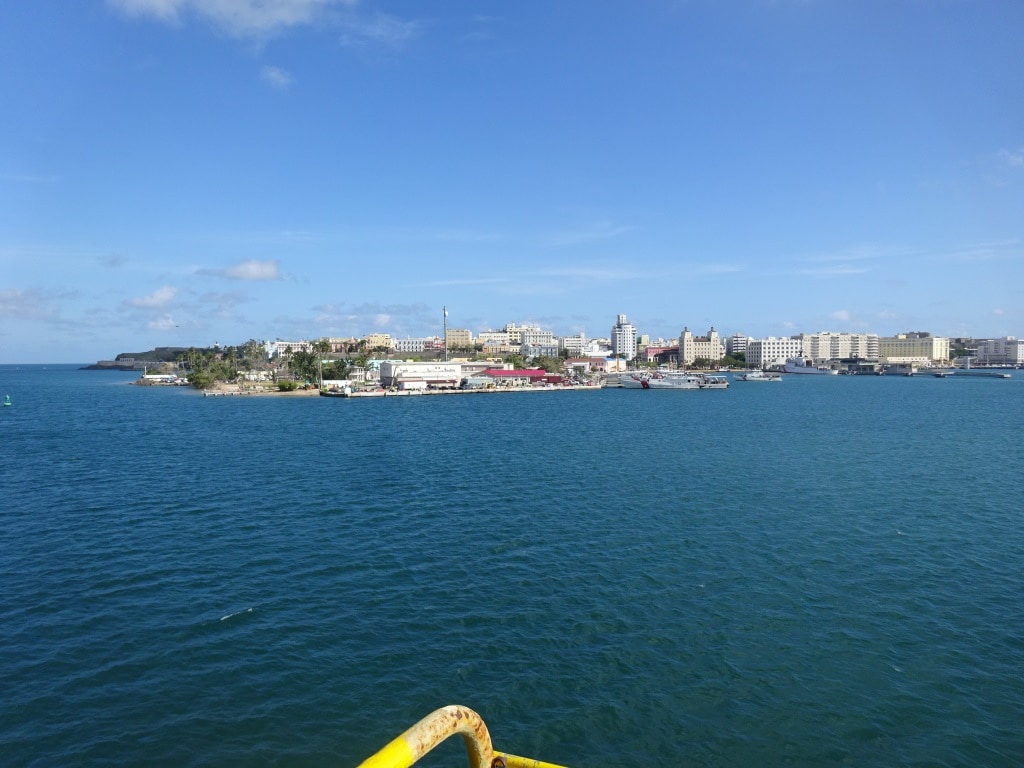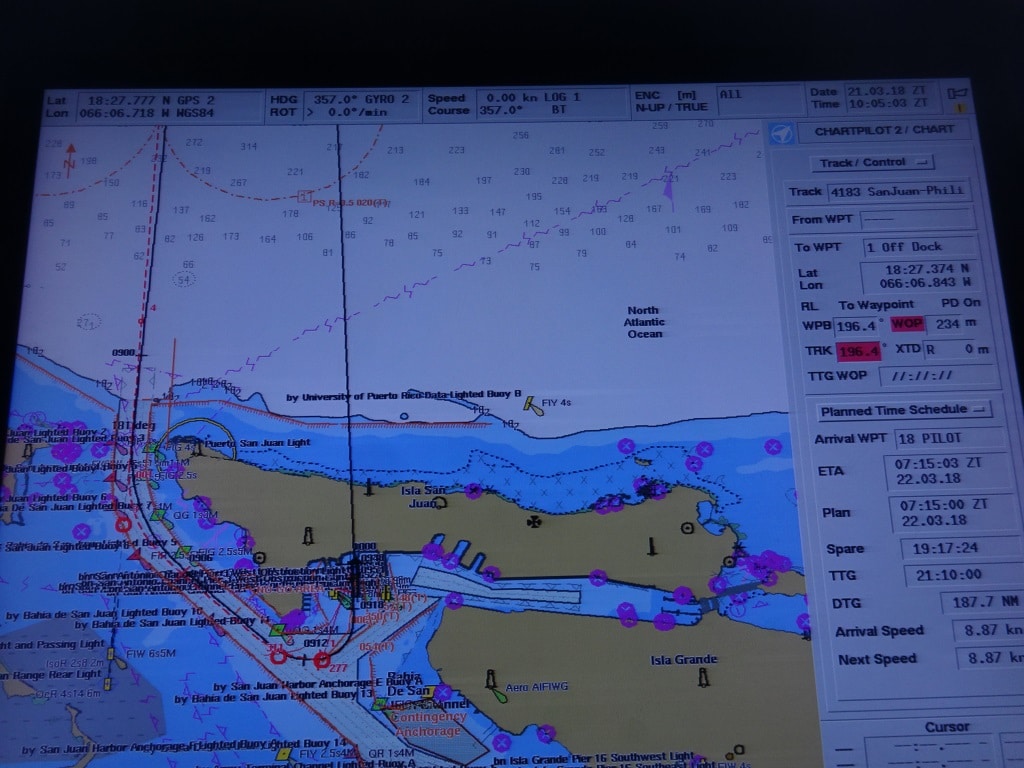At 09.00 hrs. entry into a port such as San Juan is not a bad thing. Everybody is up and about and can see the scenery while having breakfast or coffee or while being out on the open decks. We are sailing quite close by Morro Castle which dominates the entrance on the East or portside of the ship and then while turning towards the dock, the whole old town opens up in front of you. As we had perfect arrival weather, sunshine with a breeze to keep things cool, it was nice to be out there. We were in port today with one other cruise ship, the Carnival Glory, which was sitting at berth 4 east while we were given berth 3 west. Then there is Pier 1 so in total 6 docks available for cruise ships. Pier 2 is the ferry pier which has a shuttle service across the bay that makes up the big port of San Juan. When there are more ships in all the berths are filled up but with two ships, it makes sense to give each other a complete own pier as it keeps the crowds down a little bit.

San Juan old port. To the far left Morro Castle; in the middle the USCG Station, to the right Pier 1 with a big USCG cutter alongside.
All three Cruise piers are right across from the old town so it does not matter that much at which berth you are. If it is a very busy day, then cargo docks, further to the East are also pressed in service and then it becomes a long walk to the old town and the Castle. It makes the Taxi drivers happy I suppose but not the guests and the crew. Adding more berths to the West is not possible as the corner of the downtown port is taking up by the USCG station and they are not going anywhere. I wouldn’t either if you can walk straight off the boat into the pub across the street. Often USCG stations are a bit more remotely located but this one has a Class A+ location.
I have blogged about this before in the past but San Juan has the peculiar approach that you charge into the port, then go full into the brakes, the put the rudder full over and stop shortly after. All to do with the fact that the port is so close to the sea, it is just separated by a strip of land on which the Castle and the old town stands.
We sail into the harbor entrance with quite a bit of speed to prevent the ship from drifting. The Easterly (90o) Trade winds are fully perpendicular on the entrance course (181o) and the more you slow down, the more effect they have on the ship, especially on a ship with a lot of balconies. Wind likes balconies as it gives a good grip while a smooth steel surface can deflect quite a bit of wind. So we enter the harbor entrance with about 12 knots and as soon as we are behind Morro Castle and in the lee of the town, we take speed back quite quickly. Also quite quickly a turn to the South East (132o) comes up and by that time we want to be down to about six knots. The there is a course change to 090o and then, especially for Pier 1 and Pier 3 you have to make a quick 90o turn to a northerly heading. All captains like to be down to thruster speed by that time (3 knots or so) so they can control the bow in case it falls off, as now the ship comes under the influence of the Trade Wind again which blows freely through the port. Nicely helped by the City airport which is located in the middle of the port and which makes the surrounding area even flatter than it already is.

San Juan as on the Electronic chart. you can see the track of the ship while coming into the port. The area further to the right is part of the cargo port but is used for cruise ships as well during congested days. The airport is located where the two little lighthouses are in the lower right hand part of the screen shot.
The trick with docking here is, is to stay as close to the pier as possible so the ropes can be given ashore. While that is going on, there might be moments of reduced maneuverability as the ropes are near the propellers and if you start out close then you can allow for some drift when the wind gets hold of the ship.
We were docked by 10 am., our official arrival time and we had the gangways out even before that time as we do not need all the ropes ashore to be safely alongside. A number of ropes go out as insurance in case the wind suddenly increases. So while the guests were already streaming into town, we were still adding ropes to the bollards for the “in case off” situation.
Tomorrow we are in Philipsburg, St.Maarten and we will be there with one other ship, the Regal Princess. Philipsburg has two cruise docks and as there seems to be some swell running, both ships are at the West dock which is the one furthest away from the corner. The captain is also going to dock nose out so that the –sharp- bow will ride the swell, instead of the –blunt- stern and that should help a lot.
Weather for tomorrow: More of the same. Sunny, warm and breezy.
Note: For those of you who are interested, I have uploaded the Biography of Captain Eric Barhorst under the section Current Captains.

March 23, 2018 at 8:24 am
Thank you for your blogs. Great memories of arriving in San Juan on Eurodam having lunch in Tamarind looking over the castle and old town 🙂
March 23, 2018 at 5:04 pm
We took our first cruise on the Statendam in about 1977. Our first port was San Juan. We were on the top deck railing watching. As the ship ran into the dock and made a huge gash. We learned a lot of Dutch swear words as the Capt. berated the pilot. After reading today’s blog I now understand what happened. We traveled with you on the Veendam about 15 years ago.
March 23, 2018 at 7:04 pm
Thank you for reading my blog.
Nowadays, the captain keeps the pilot near the coffee machine when possible and we do it ourselves using the pilot
purely as an adviser and not as an executor.
Best regards
Capt. Albert